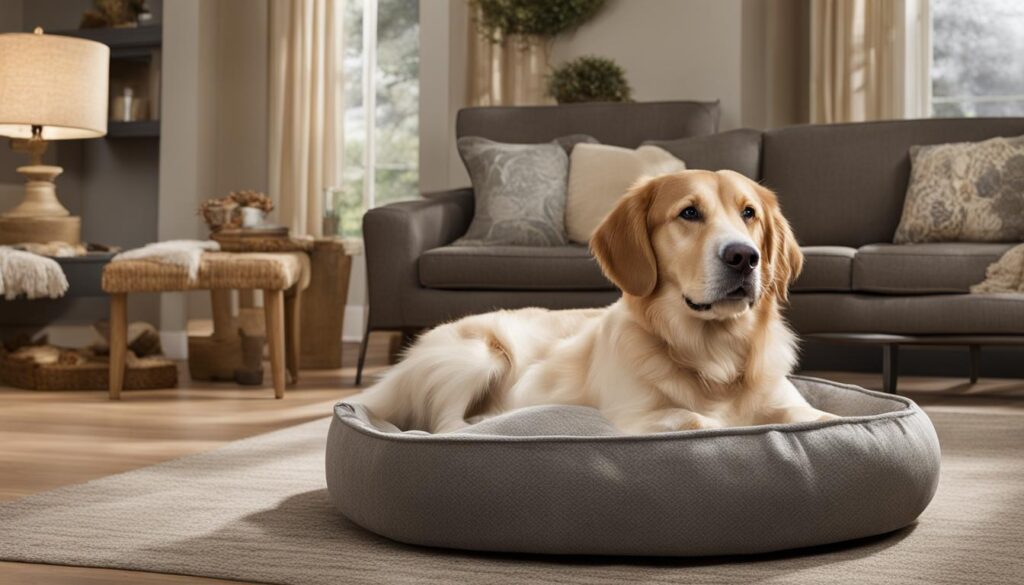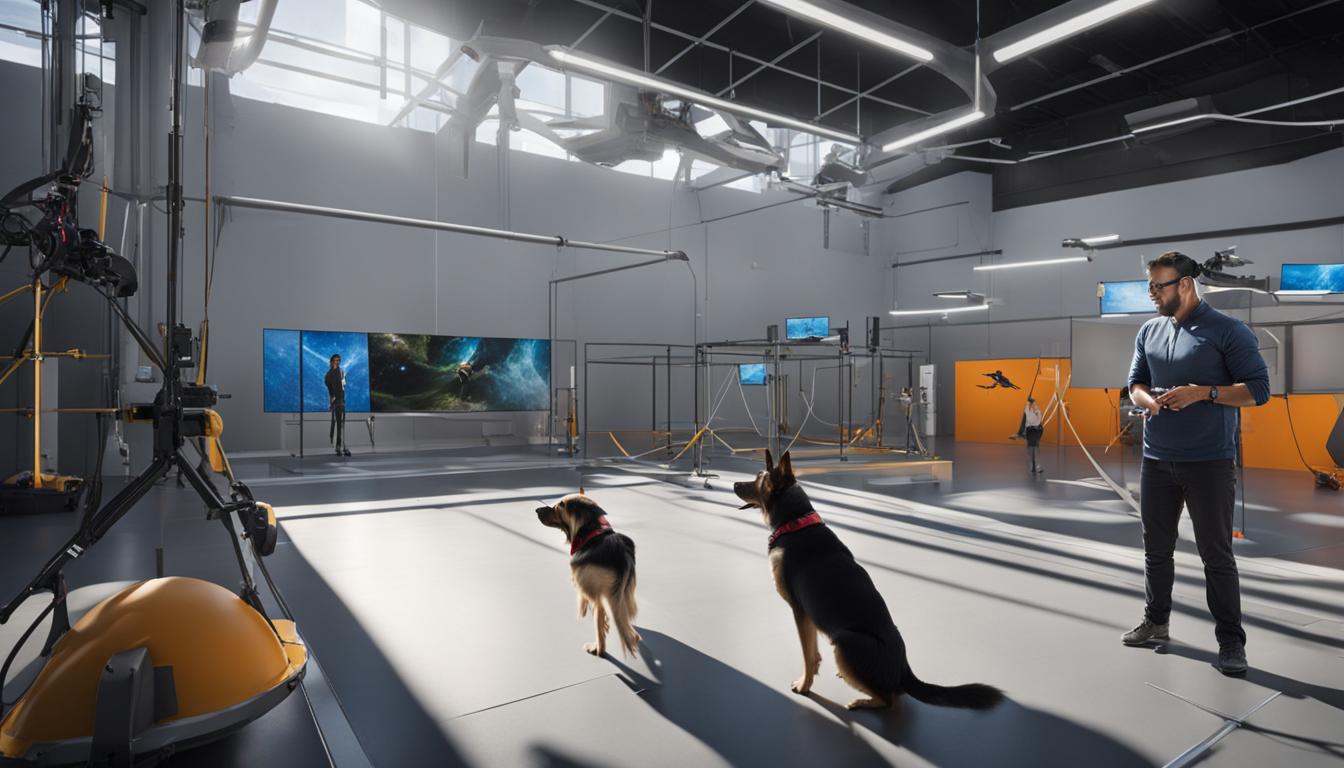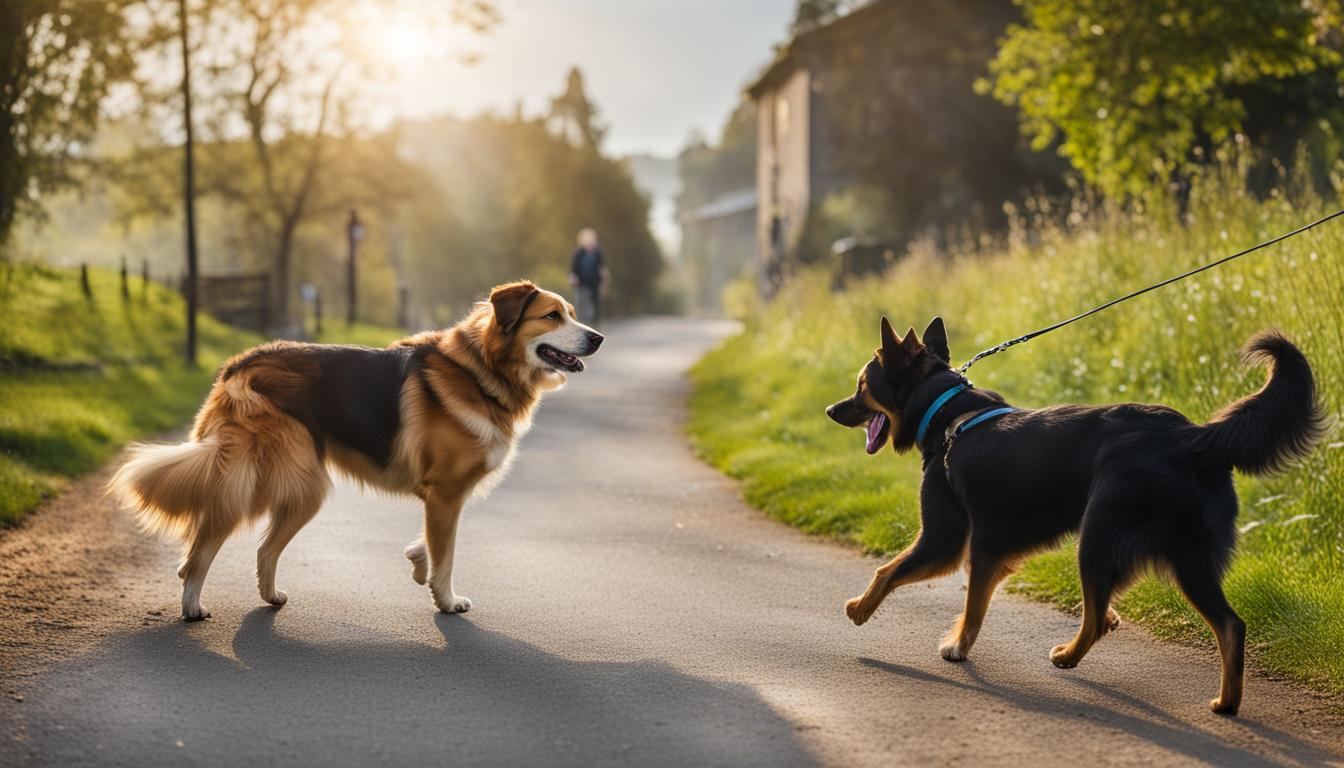Welcome to our guide on the fascinating topic of the role of environment in shaping dog behavior. As a dog owner, you play a crucial role in creating a harmonious and stimulating environment for your furry friend. By understanding how the home environment, outdoor space, and social environment impact your dog’s behavior, you can make informed decisions to ensure their well-being and happiness.
Key Takeaways:
- The environment is a significant influencer of a dog’s behavior and well-being.
- The home environment, outdoor space, and social environment all play a role in shaping a dog’s behavior.
- Adapting the living space to meet a dog’s needs can reduce stress and promote positive behavior.
- Providing environmental enrichment in the form of toys, activities, and sensory experiences is essential for a dog’s mental and physical well-being.
- Positive socialization experiences and appropriate training are crucial for a dog’s behavior and interactions with others.
The Impact of Home Environment on Dog Behavior
The home environment plays a crucial role in shaping a dog’s behavior. Just like humans, dogs thrive in an environment that meets their needs and provides stimulation. By adapting living spaces to accommodate a dog’s behavior, owners can create a harmonious and fulfilling environment for their furry friends.
One important aspect to consider when adapting the home environment is the layout and arrangement of the living space. Creating designated areas for rest, play, and feeding can help establish routines and provide a sense of structure for dogs. Additionally, ensuring easy access to resources like water, food, and toys can prevent frustration and promote positive behaviors.
Environmental enrichment activities are also key in creating a stimulating environment for dogs. Providing interactive toys, puzzle games, and sensory experiences can keep dogs mentally and physically engaged, reducing boredom and preventing destructive behaviors. Enrichment can include activities such as hiding treats around the house or setting up obstacle courses, encouraging dogs to use their natural instincts.
“A well-designed home environment can greatly influence a dog’s behavior and well-being. By adapting living spaces and providing environmental enrichment, owners can create a stimulating and fulfilling environment that promotes positive behaviors.”
In summary, adapting the home environment to accommodate a dog’s behavior is essential for their overall well-being and behavior. By considering the layout of the living space, providing easy access to resources, and incorporating environmental enrichment activities, owners can create a nurturing and stimulating environment that promotes positive behaviors in their canine companions.
| Benefits of Adapting the Home Environment | |
|---|---|
| 1 | Enhances overall well-being and behavior |
| 2 | Reduces stress and boredom |
| 3 | Promotes mental and physical stimulation |
| 4 | Prevents destructive behaviors |

Creating a Stimulating Environment for Dogs
Creating a stimulating environment for dogs involves considering their natural instincts and providing opportunities for mental and physical engagement. Here are some additional ways to create a stimulating environment:
- Set up scent games where dogs can use their keen sense of smell to find hidden treats or toys.
- Provide different textures and surfaces for dogs to explore, such as grass, sand, or mats.
- Rotate toys regularly to keep dogs interested and prevent boredom.
- Introduce new and safe sounds, such as calming music or nature sounds, to create a soothing atmosphere.
- Establish a routine that includes regular exercise, training sessions, and playtime to provide structure and mental stimulation.
By incorporating these strategies into the home environment, owners can create a dynamic and engaging space that promotes positive behaviors and enhances the overall well-being of their dogs.
The Influence of Outdoor Space on Dog Behavior
When it comes to shaping a dog’s behavior, the outdoor space they have access to plays a crucial role. Dogs are naturally active animals, and having a safe and secure outdoor area allows them to engage in physical exercise and explore their surroundings. This physical activity is essential for their mental and physical well-being.
One way to promote a positive outdoor experience for dogs is by providing environmental enrichment. This can include adding agility equipment, such as jumps, tunnels, and weave poles, to create a stimulating and challenging outdoor environment. Interactive toys, such as puzzles or treat-dispensing toys, can also keep dogs mentally engaged while they explore the outdoor space.
It’s important to tailor the outdoor space to meet a dog’s specific needs. Consider factors such as the dog’s breed, size, and energy level when designing the outdoor area. For example, a high-energy dog may benefit from a larger outdoor space with plenty of room to run and play, while a smaller breed may prefer a smaller, more contained space. Providing shade and water sources is also essential to ensure the dog’s comfort and safety during outdoor activities.
| Benefits of Outdoor Space for Dogs: | Considerations for Tailoring Outdoor Space: |
|---|---|
| Physical exercise and mental stimulation | Size of the outdoor area |
| Exploration and sensory experiences | Availability of shade and water |
| Socialization with other dogs | Presence of environmental enrichment |
| Opportunity for natural behaviors, such as digging or sniffing | Safety and security of the outdoor space |
By optimizing the outdoor space for dogs, owners can create an environment that promotes their physical and mental well-being. Incorporating environmental enrichment and considering the dog’s specific needs when designing the outdoor area can result in a balanced and contented dog.

The Influence of Social Environment on Dog Behavior
The social environment plays a vital role in shaping a dog’s behavior. Interactions with other dogs, animals, and people can have a significant impact on a dog’s socialization, behavior, and overall well-being. Positive socialization experiences during the critical period of development can help dogs become well-adjusted and confident individuals.
Exposing dogs to a variety of social situations is essential for their ability to discern genuine threats from benign situations. For example, introducing them to different people, animals, and environments can help them develop the necessary skills to navigate social interactions effectively. It also ensures that they become comfortable and confident in various environments, reducing the likelihood of fear or reactivity towards new experiences.
“Proper socialization, training, and management of the social environment are key to preventing behavioral issues and promoting positive interactions.”
Environmental factors greatly influence the effectiveness of dog training. A positive and supportive social environment can enhance training outcomes and improve a dog’s response to commands and cues. Consistent exposure to different individuals, situations, and stimuli helps dogs develop resilience and adaptability, enabling them to handle new experiences calmly and confidently.
| Environmental Factors Affecting Dog Training | Impact |
|---|---|
| Positive reinforcement | Encourages desirable behavior and strengthens the bond between the dog and the owner/trainer |
| Consistency and routine | Provides structure and clarity, making it easier for dogs to understand and comply with training commands |
| Socialization opportunities | Expose dogs to new situations, people, and animals, helping them become more adaptable and well-behaved in various social settings |
| Positive role models | Allow dogs to observe and learn from well-behaved and trained dogs, facilitating their own learning and behavior modification |
| Introduction to distractions | Gradual exposure to distractions during training sessions improves a dog’s focus and ability to stay attentive in distracting environments |
Creating a positive social environment for your dog involves providing opportunities for positive interactions with other dogs and individuals, implementing consistent and reward-based training methods, and managing the exposure to various social situations. By prioritizing socialization and training in a supportive environment, you can help your dog develop the necessary skills and behaviors to thrive in different social settings.

Conclusion
Congratulations on taking the time to understand the impact of the environment on your dog’s behavior. By effectively managing the home environment, outdoor space, and social environment, you can create an environment that promotes positive behaviors and reduces stress for your furry friend.
Remember, the home environment plays a crucial role in shaping your dog’s behavior. Adapting your living space to accommodate your dog’s needs, providing interactive toys, and creating designated areas for rest and play can make a world of difference. Creating a structured and stimulating environment will enhance your dog’s well-being and happiness.
Outdoor space also plays a significant role in your dog’s behavior. Having a safe and secure outdoor area allows your dog to engage in physical exercise and explore their surroundings. Adding enrichment activities like agility equipment and sensory experiences will contribute to a balanced and contented dog. Tailoring the outdoor environment to suit your dog’s breed, size, and energy level will ensure they thrive.
Lastly, the social environment is vital for your dog’s development. Positive socialization experiences with other dogs, animals, and people will help your dog become well-adjusted and confident. Exposing them to different situations, individuals, and stimuli will enable them to discern genuine threats from harmless situations. By focusing on proper socialization, training, and management of the social environment, you can prevent behavioral issues and foster positive interactions.
In conclusion, understanding the influence of the environment on your dog’s behavior is key to creating a nurturing and stimulating environment. Tailoring the environment to meet their needs and considering environmental triggers will help manage and shape their behavior. By doing so, you’ll ensure a happy and well-behaved canine companion.
FAQ
How does the environment impact a dog’s behavior?
The environment, including the home environment, outdoor space, and social environment, plays a crucial role in shaping a dog’s behavior. Factors such as the layout and arrangement of the living space, availability of resources, and socialization experiences all contribute to a dog’s behavior and well-being.
How can I adapt my living space to meet my dog’s needs?
You can adapt your living space by creating designated areas for rest and play, providing interactive toys, and considering the layout of the space. A structured and stimulating environment that meets your dog’s needs can help alleviate stress and promote positive behavior.
What impact does outdoor space have on a dog’s behavior?
Access to a safe and secure outdoor area allows dogs to engage in physical exercise and explore their surroundings. Providing environmental enrichment such as agility equipment, toys, and sensory experiences can enhance a dog’s mental and physical well-being. Tailoring the outdoor space to meet your dog’s specific needs is important for a balanced and contented dog.
How does the social environment affect a dog’s behavior?
Interactions with other dogs, animals, and people can impact a dog’s socialization, behavior, and overall well-being. Positive socialization experiences during the critical period of development can help dogs become well-adjusted and confident. Proper socialization, training, and management of the social environment are key to preventing behavioral issues and promoting positive interactions.
How can I manage and shape my dog’s behavior through the environment?
By understanding and managing the home environment, outdoor space, and social environment, you can create a nurturing and stimulating environment for your dog. Adapting living spaces, providing environmental enrichment, and ensuring positive socialization experiences contribute to your dog’s well-being and behavior. By considering environmental triggers and tailoring the environment to meet your dog’s needs, you can effectively manage and shape their behavior.





